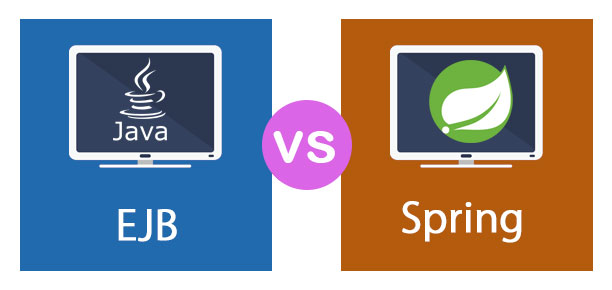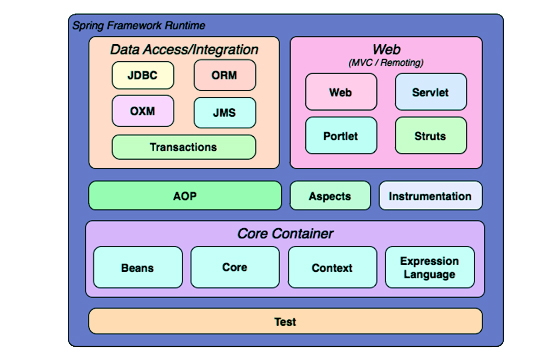Updated May 19, 2023

Difference Between EJB and Spring
EJB is an acronym for Enterprise Java Beans. EJB is a Java API for server-side architecture for transactional, component-based distributed programming. EJB specifies the bean format and defines a set of services that must be provided by the container on which the bean runs. Thus, a developer should not be concerned with the service details such as security, transaction support, or remote object access. To run an EJB application, you need an application server, i.e., EJB containers such as JBoss, WebLogic, WebSphere, etc.
Java Spring is a lightweight open-source framework that supports various frameworks such as Hibernate, EJB, JSF, Tapestry, etc. Spring framework has a layered structure, allowing you to choose the required component at the start of the development. Spring framework offers Inversion of Control (IOC), Aspect-Oriented (AOP), Transaction Management, JDBC Exception Handling, etc. That allows the developer to concentrate on the business requirement rather than the architectural details of the application.
Head-to-Head Comparison Between EJB and Spring
Below are the top 10 differences between EJB and Spring.

Key Differences Between EJB and Spring.
Let us discuss some of the major differences between EJB vs Spring:
- EJB vs Spring’s main difference is that EJB is a specification of Java EE, whereas Spring is a framework or an implementation.
- EJB is an architecture for transactional, component-based programming. It makes server-side development much easier for the Java developer. Spring framework is a Java platform that supports developing the Java application. The framework handles the infrastructure configuration and lets the developer focus on business requirements.
EJB Architecture

- The EJB framework separates the business logic from the low-level details so that the developer can concentrate on the business requirement. Unlike legacy systems that use many SQL queries, EJB architecture does not use SQL queries directly; instead, it uses a model-view-controller design pattern where queries are wrapped inside the EJB container so that data can be assessed through EJB.
- At the center of the application, an EJB container manages a set of enterprise beans. This bean manages the connection with the backend database systems, typically a relational database. As you know, in the Spring framework, this is handled by the Data Access or the Integration module.
- In EJB, the web container uses JSP to access the EJB beans; it transforms the JSP to HTML and then serves the HTML to the browser. In Spring, this is being handled by the Web module.
- In EJB, the middle tier, i.e., The enterprise beans, are a wrapper over various systems, such as the relational database. There are two types of enterprise beans, i.e., entity and session beans. On a high level, session beans represent activity, an entity bean represents entities of the application. An entity bean is a persistent object stored in a storage system such as a database. On the contrary, Spring, the framework, uses a web container for session management.
Spring Architecture

- Spring framework has about 20 modules and offers various features. These modules are logically grouped into Data Access/ Integration, Web, AOP, Aspects, Instrumentation, Core container, and test.
- The core container consists of the core, beans, context, and Expression language modules. The core and Bean modules provide features such as IoC and Dependency Injection.
- The Data Access/ Integration layer provides transaction modules like JDBC, JMS, ORM, OXM, etc. The JDBC module provides a JDBC abstraction layer that removes the need to code the configuration code required to establish a connection with a database.
- The ORM module supports popular object-relational mapping APIs like JPA and Hibernate. Unlike EJB, which only supports JPA.
- The web layer consists of Web-Struts, Web-Servlet, and Web-Portlet modules. The web-servlet module contains Spring’s MVC implementation for web applications. It provides a clean separation between the web forms and the business logic layer.
- Spring AOP modules provide an AOP Alliance-compliant aspect-oriented programming that lets you cleanly define method interceptors to decouple functionality.
- The test module provides support for JUnit or TestNG.
EJB vs Spring Comparison Table
Let us discuss the topmost differences between EJB and Spring.
| Basis of comparison | EJB | Spring |
| Transaction Management | EJB supports only the JTA transaction manager. | Through its PlatformTransactionManager interface, Spring supports multiple transactions such as JTA, Hibernate, JDO, and JDBC. Uses JTA transaction manager to support distributed transaction |
| Dependency Injection | It can inject EJB’s data, JMS, and JPA resources into the container. | Lists, properties, maps, and JNDI resources can be injected. |
| Persistence | It supports programmatic bean-managed persistence and is tightly coupled to JPA. | It provides a framework that supports integrating various persistence technologies like JDBC, Hibernate, JDO, and iBATIS. |
| State Management | Supports stateful session beans and extended persistence context. | Supports Web container session management |
| Web Services | Supports stateful session beans and extended persistence context. | It does not support any direct web service integration. |
| Security | It supports both declarative and programmatic security support through JAAS. Supports declarative security through Users and roles. Declarative security is configured in the deployment descriptor file. |
No box security implementation. However, it provides declarative security through the spring configuration file or class metadata. Acegi is an open-source security framework built on top of Spring. |
| Distributed Computing | Provides container-managed remote method calls. | It supports remote calls via RMI, JAX-RPC, and web services. |
| Messaging | It supported out-of-the-box messaging. Capabilities through Message Driven Beans. |
For the message, the listener’s configuration needs to be added. |
| Scheduling | Provides simple scheduling through EJB Timer service | For scheduling, we need to add and configure Quartz. |
| AOP | It provides limited support through interceptors. | Support the AspectJ and Spring AOP alliance |
Conclusion
Every technology has advantages and disadvantages, and before choosing any specification or framework, it is essential to understand the pros and cons. This article shows that EJB is a specification of J2EE, whereas Spring is a framework for easy implementation, even though some areas overlap. We have seen the differences in the architecture and discussed some of the EJB and spring offers to the developer.
With the difference matrix, we can conclude that if you want advanced features like AOP and more control over the application, go with the Spring framework. If you do not want to go deep into the database’s configuration details and the application is very stateful, go with EJB.
Recommended Articles
This has been a guide to EJB vs Spring. Here we discuss EJB vs Spring key differences with infographics and a comparison table. You can also go through our other suggested articles to learn more –


